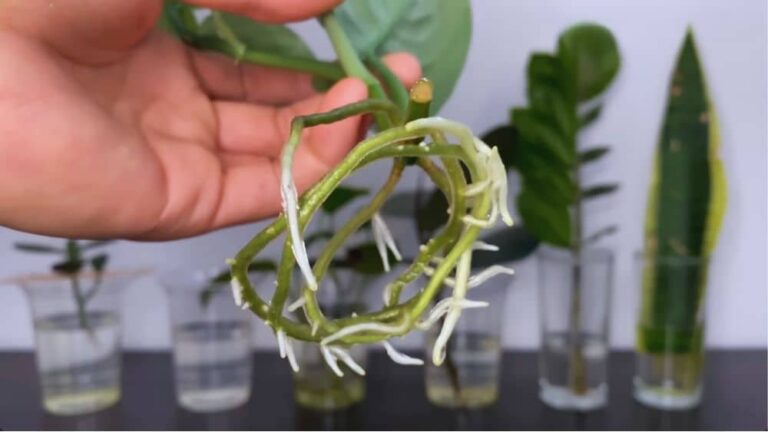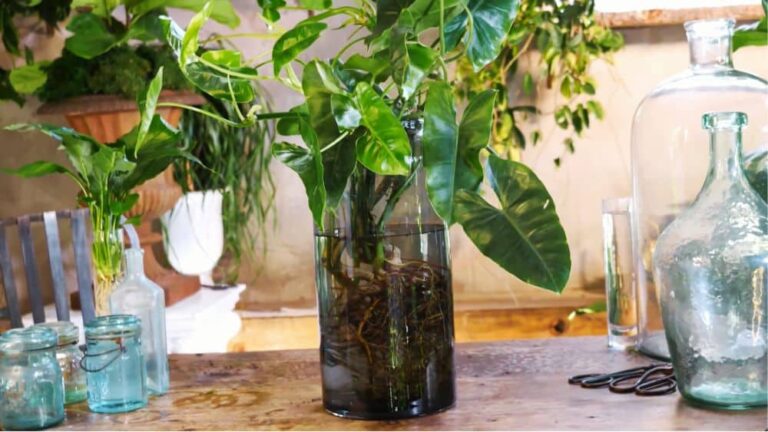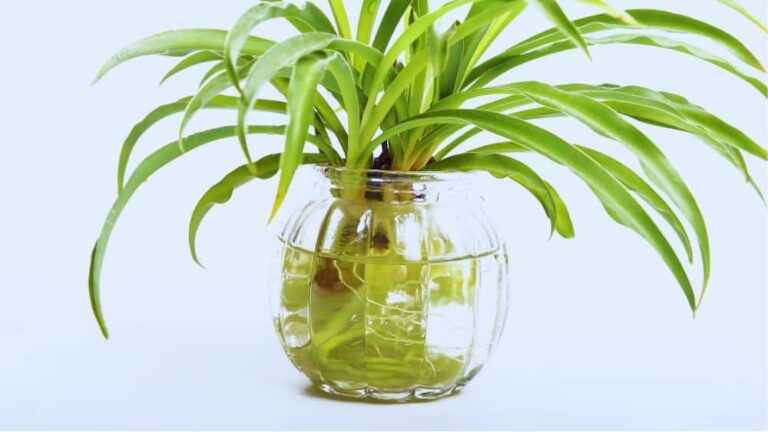Hydroponic House Plants: Revolutionizing Indoor Gardening
Are you interested in caring for plants without handling dirt and watering them constantly? Welcome to the world of hydroponic houseplants—a significant change in how people grow plants indoors.
This revolutionary way of caring for plants isn’t just a fad; instead, it’s a long-term revolution offering an alternative to old-fashioned methods that fit modern lifestyles.
For many generations, Americans have enjoyed growing traditional house plants. Caring for a plant rooted in the earth is deeply satisfying, providing not only cleaner air but also enhancing the aesthetics of our living spaces.
However, as city life changes and people become more concerned about the environment, hydroponic house plants are becoming more popular. These soil-less gardening miracles are changing how we do home gardening by improving it to be more efficient and better for the environment.
No matter how much room you have or what you know about gardening, hydroponics makes gardening possible in all kinds of places, from high-rise city apartments to tiny homes.

What are Hydroponic House Plants?
Hydroponic houseplants are a big step forward in botanical technology. They take us back to old times while using the latest technology. The term “hydroponic” originates from the Greek words “hydro,” meaning water, and “ponos,” meaning work.
This method replaces soil with a nutrient-rich water solution. Inert mediums, such as perlite, rock wool, or clay pellets, support root systems by keeping them stable and letting them get nutrients.
This method isn’t entirely novel; it echoes ancient civilizations’ creativity, such as the Hanging Gardens of Babylon, one of the Seven Wonders of the Ancient World. Although it is relatively new to home gardening, its versatility and sustainability make it more appealing. From suburban homes to busy city high-rises, people around the U.S. use hydroponic systems to grow their favorite plants.
Benefits of Hydroponic House Plants
They are effective for many reasons, including:
Faster Growth Rate: Since nutrients are sent directly to the roots of plants with hydroponic systems, they grow faster than plants grown in dirt.
Less chance of soil-borne diseases: As there is no soil, there is a much smaller chance of soil-borne diseases like root rot.
Innovative Use of Nutrients and Water: Hydroponic systems reuse water, which makes them very water-efficient. Especially in places where water is limited, that is very helpful.
Spatial Flexibility: Hydroponic plants can be placed in various indoor settings without natural light sources. This flexibility is excellent for interior design enthusiasts, allowing for creative plant displays in spaces previously unsuitable for traditional gardening.

Comparing Traditional Gardening with Hydroponics Indoor Plants
There are some main differences with traditional gardening that you should know:
Soil vs. Nutrient Solution: Traditional farming uses soil, but it can become messy and requires frequent fertilization. Hydroponics, however, uses a clean, nutrient-rich water solution that is simple to control and change.
Upkeep and care: Unlike traditional plants, hydroponic houseplants are easier to care for and require less effort; they need to be watered less frequently and are less susceptible to pests and diseases.
Cost-Effectiveness Over Time: Setting up a hydroponic system can be more expensive initially, but using less water and needing less maintenance over time can make it an excellent choice for many households.
Getting Started with Hydroponic Houseplants
To begin hydroponics, follow these steps:
Picking the Right System: There are different hydroponic systems for beginners and experienced growers:
- Deep Water Culture (DWC) is particularly suitable for beginners due to its ability to submerge plant roots in a nutrient solution. This method ensures a continuous supply of nutrients and air.
- The Wick System is a quiet option suitable for small plants, delivering nutrients to the roots through a wick.
- The Nutrient Film Technique (NFT) involves a continuous flow of nutrient solution over the roots, making it space-efficient for setups with limited room.
Plant Selection: Not all plants can be grown hydroponically. Leafy greens like lettuce, aromatic herbs such as basil and mint, and certain houseplants thrive in these systems. Understanding the specific needs of each plant type is crucial for successful hydroponic gardening.
Preparing a Nutrient Solution and pH Balance: A balanced solution is vital for plant health. Maintaining a pH of 5.5 to 6.5 ensures your plants absorb nutrients effectively. Also, it should follow the recommendations for each plant.

How to Care for Houseplants Grown in Water
Caring for hydroponic houseplants is not the same as caring for dirt plants. Check out these care tips:
Monitoring Nutrient Levels: Check your hydroponic system’s nutrient levels regularly. Too much can lead to nutrient burn, while too little can result in deficiencies. An EC (Electrical Conductivity) meter can ensure adequate plant nutrients.
Ensuring Adequate Lighting: While hydroponic plants don’t rely on natural sunlight, they still require sufficient light to photosynthesize. LED grow lights are popular because they are energy-efficient and produce less heat.
Position the lights close enough to the plants to promote their growth while ensuring they are far away to prevent burnt leaves. The recommendation is to give them 14 to 16 hours of light every day.
Regular Checks for Pests and Diseases: Although hydroponic plants are less susceptible to earth-borne diseases, they are still vulnerable to pests and diseases that spread through the air and soil.
Check your plants often for signs of infection or infestation, like changes in leaf color or a halt in growth. Implementing integrated pest management (IPM) strategies can help sustainably control these issues.
Maintaining the System: It is essential to clean the hydroponic system regularly to stop algae growth and salt buildup. Clean and sterilize the containers, and change the nutrient solution every few weeks to maintain a healthy growing environment.
Challenges and Solutions in House Plant Hydroponics
Hydroponic gardening can be helpful, but it also has some problems, especially for beginners:
Nutrient Imbalance: Finding the right mix of nutrients can be challenging. The wrong amount of chemicals can hurt plant health. Utilize nutrient testing kits to check nutritional levels and adjust concentrations regularly.
Lighting Issues: Plants can only grow if they get enough light. You can measure the illumination intensity with a light meter to ensure your plants get enough light. You could set a timer to control the light and dark phases.
Maintaining Water Quality: Clean water is critical in hydroponic systems. Check the water’s pH often. For most plants, it should be between 5.5 and 6.5. Watch the temperature as well. For maximum growth, keep it between 65°F and 75°F (18°C and 24°C).
Success Stories of Hydroponic House Plants
Hydroponic gardening has many success stories, both personal and commercial:
Personal Success: Jane, a hobbyist from New York, shared her experience growing basil using the DWC system. With careful monitoring of nutrients and light, she cultivated a thriving basil plant that became the envy of her friends.
Commercial Impact: Urban Greens, a start-up in Chicago, has effectively utilized hydroponics to grow herbs and greens, demonstrating hydroponic gardening’s commercial viability. They supply fresh produce to local markets, reducing their carbon footprint.
Following these rules and suggestions, you can grow hydroponic plants at home. Indoor gardening with hydroponic systems has a bright future, whether you want to grow plants for fun or to make money.
The Environmental Impact and Sustainability of House Plants in Hydroponics
Reusing and conserving water
Hydroponic houseplants are known for their high water efficiency. People who garden in soil lose water as it evaporates and runs off. Hydroponic systems, on the other hand, recycle water and use every drop for plant growth. That is especially true in places with limited water, making hydroponics an ideal solution.
Less use of herbicides and pesticides
Hydroponic systems for houseplants also reduce pesticides and herbicides use. Closed-off and controlled systems reduce weeds and pests from entering. Besides keeping your garden safe, it protects the environment by preventing chemicals from entering waterways.
Urban Farming and Local Food Production
Some hydroponic houseplants are just for aesthetic purposes; others grow food, like herbs and veggies. It makes urban gardening possible so city residents can grow food in small areas. Hydroponics lowers carbon emissions and encourages local food production by cutting down on storage and shipping.

FAQ Section: House Plant Hydroponics
What are hydroponic indoor plants?
Hydroponic houseplants are grown without soil but in a nutrient-rich water solution. The roots get food directly from the water.
How do hydroponic house plants differ from traditional potted plants?
Hydroponic house plants grow in water instead of dirt like regular potted plants. That means they grow faster and get fewer diseases.
What are the benefits of hydroponic house plants?
Faster growth rates, a lower chance of soil-borne diseases, more efficient use of nutrients and water, and the ability to grow plants anywhere, even if they don’t get direct sunlight, are all benefits.
What types of plants are suitable for hydroponics?
Hydroponic systems work well for lettuce and other leafy veggies, herbs like basil and mint, and some houseplants.
How do I start with houseplants that grow in water?
Select the appropriate hydroponic system, choose the right plants, make the nutrient solution, and ensure the pH level remains constant.
What are the common challenges in hydroponic gardening?
Some common problems are keeping the correct balance of nutrients, ensuring enough light, and keeping diseases and pests away.
Is hydroponic gardening environmentally friendly?
Yes, it saves water, minimizes chemical use, contributes to urban agriculture and food production, reduces transportation and storage, and protects the environment.
At the end
Hydroponic house plants have many potential uses in the future. They help the environment in many ways, like saving water and reducing chemicals. They are also an effective way to farm in cities without harming the environment. Because of these benefits, hydroponics is more than just a trend; it’s a revolutionary way to garden indoors.
If you’re interested in what’s possible, consider hydroponics for your home plants. In addition to investing in your health, you also invest in the planet’s future.
Additional Resources
Other Books, Online Courses, and Tutorials You Might Like:
“Hydroponics for House Plants” by Jane Doe: A Complete Guide for Beginners
Online Course: “Mastering Hydroponics”: Discover these methods of growing plants in water.
“Hydroponic House Plants 101” YouTube Tutorial Series: Free video guides for DIY hydroponics.
By following these guidelines and resources, you’ll be well on your way to creating a sustainable, efficient, and beautiful indoor garden. Whether you’re a seasoned gardener or a novice, hydroponic house plants offer an exciting avenue for growth and exploration.
CTA:
Are you ready to plant in water? Begin your trip now and help make a better future!

Meet Milan Cole, your urban gardening pro!
Milan Cole, chief content writer at Maven Gardening and an urban gardening expert, is passionate about helping city dwellers cultivate their green thumbs. Armed with extensive horticultural knowledge, Milan provides practical advice for overcoming urban gardens’ challenges, like limited space, water scarcity, and reduced sunlight.
His expertise extends beyond traditional methods, encompassing innovative approaches like hydroponic and aquaponic systems and sustainable gardening practices. Milan skillfully adapts these techniques to urban environments, considering factors like pollution and climate change.
In his clear and concise writing, Milan offers actionable solutions for anyone wanting to bring life to an urban space. He shares valuable insights into growing herbs in tight spaces, maximizing the potential of window boxes, and transforming even the most miniature balconies into thriving green oases.
Milan’s guidance is straightforward and practical, making it ideal for anyone looking to cultivate their own urban garden, regardless of prior experience.
Join Milan Cole on your journey to metropolitan Eden!
